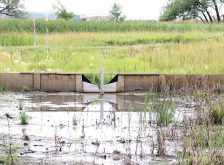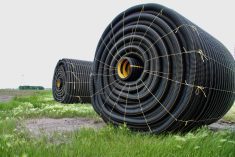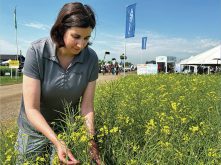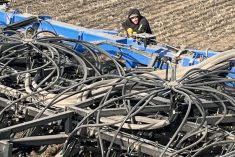Western Canadian farmers like their tile drainage projects. They are not particularly cheap improvements. Costs vary widely depending on size and complexity of the project but, on average, figure on about $1,000 per acre to get pipe in the ground.
But the benefits, according to this October’s farmer panel members, are many:
- A tile drainage project gets standing water or waterlogged conditions off the field, making it possible to put more acres into production.
- In some areas, it helps remove the salinity from the soil as salts are carried away with the water.
- With tile drainage, the timeliness of all field operations is improved, you can be out there sooner seeding or combining after spring runoff or a rain, for example.
- Hopefully, improved soil and field conditions will translate into higher yields and improved crop quality.
- In some cases, municipalities might see reduced damage to infrastructure, such as roads, as flooding conditions are better managed or prevented.
- There is the always important peace of mind that comes with being better able to manage through extreme weather conditions.
Read Also

Claas brings 1000 Series SP forage harvesters to Canada
In mid-August, Claas unveiled its new line of Jaguar forage harvesters at an event in Visalia, California, deep in the heart of that state’s dairy region.
Tile drainage projects must be properly planned, however, often requiring expert services to design the projects to ensure they do what they are intended to do — that they don’t just transfer a water problem to downstream neighbours — and to ensure the environment or wildlife habitat is not adversely affected.
Saskatchewan has even developed what’s known as a Qualified Persons Training Course to train qualified people — consultants — in tile drainage planning.
- Read more: The value and benefits of tile drainage
- Read more: When is tile drainage a good fit?
According to producers who have been through the process, Manitoba has some very manageable regulations that accommodate tile drainage. In what was considered a real change in attitude, Saskatchewan in recent years has developed a comprehensive yet manageable regulations and permit system to accommodate tile drainage projects. And Alberta regulations can be more onerous and more of a hindrance than a help “creating too many hurdles for farmers to want to follow through with tile drainage projects,” farmers say.
Does talking about tile drainage seem crazy after one of the driest growing seasons in recent memory? Not really, say panel members. It is during the dry periods that it is easier to install drainage components and be ready for the rain, or runoff, when it comes.
While there are a lot of ins and outs concerning tile drainage planning and installation, here is a quick review of what October’s farmer panel members have done with tile drainage on their farms.
Owen Orsak
Binscarth, Man.
Owen Orsak says installing tile drainage on part of his southwest Manitoba farm has greatly increased his cropping efficiency.
He bought his own tile plow in 2015 and installed tile drainage on several “five- and 10-acre parcels” over the next three years, which effectively removed standing water from potholes scattered over several fields. And then just this past spring of 2021, he hired a commercial tile drainage contractor to install a more extensive network of drainage tile over about 300 acres.
“In total, we have about 600 acres covered by tile drainage,” says Orsak, who crops about 5,000 acres of grains and oilseeds near Binscarth, which is just east of the Saskatchewan border. “In general terms, with tile drainage, if you treat about 10 per cent of your acres it effectively drains about 100 per cent of your farm.”
Orsak’s farm includes some rolling land above the Assiniboine River. Fields with slopes in them drain down to some of the flatter land, which is where most of the tile drainage was installed.
“On that larger field we did this year, some years at seeding there used to be 28 potholes holding water,” he says. “Then when you came back two weeks later, there might be only two potholes — they’d dry up. But when we started spraying there would be 28 again. It wasn’t permanent standing water but depending on the timing of rainfall, we would have these wet spots to work around.”
This past spring, he was in the field seeding just as the tile contractors had finished and were cleaning up their equipment. Four days after seeding the area received 5.5 inches of rain. “There was not one pothole after that rain,” he says.
Orsak says probably the greatest benefit with tile drainage is improved efficiency. “It is more efficient time-wise, fuel-wise and input-wise,” he says. “I’m not steering around potholes to get the field seeded. I’m not spending three hours trying to get the seed drill unstuck because the operator got too close to a wet spot, and I’m not trying to turn the sprayer around these wet spots and creating a lot of overlap. It used to be a 260-acre field with 28 wet spots, so I would seed 240 acres and probably combine 220 acres. Now I can seed 260 acres and combine 260 acres.”
Craig Millar
Birsay, Sask.
Craig Millar installed tile drainage on about 30 acres under one irrigation pivot about six years ago, which he says has clearly paid for itself, but he figures just about all the land under the 15 irrigation pivots on his south-central Saskatchewan farm could benefit from some amount of tile drainage.
Millar, who crops about 5,000 acres of dryland and irrigated grains and oilseeds near Birsay west of Diefenbaker Lake, says he was hoping the tile drainage would stop the spread of soil salinity, which seemed to be expanding a bit each year. “We were pleasantly surprised to see after a few growing seasons that the saline area is actually decreasing in size,” he says. “The tile drainage is helping carry the salts away.”
“Under that 130-acre pivot, for example, it was like there was a line across it,” says Millar. “The west half produced 25 to 30 bushels more than the east half. The east half had more lower areas with these sour spots of salinity that were expanding. Some years we’d have to seed them separately because the east half would be too wet, and then it would ripen later and there was always the risk of losing the crop to frost.”
Once those 30 acres of tile drainage were installed on the east half, the story changed. Salinity began to decline and he could seed both halves at the same time as well as combine them at the same time. “The yield lag went from 25 to 30 bushels to maybe 10 bushels,” he says. “It cost us about $30,000 but I have easily recouped those costs.”
Millar has bought his own tile plow now and plans to treat more problem spots under more acres over the seasons to come. “I’m really excited about tile drainage,” he says. “I believe it could benefit much of the land within the Luck Lake Irrigation District.”
Stewart Ringdal
Broderick, Sask.
Stewart Ringdal is hoping about 160 acres of tile drainage that was installed over three separate quarter sections of irrigated cropland on their south-central Saskatchewan farm earlier in 2021 will help reduce the amount of salinity he’s seen building up on some of their soils.
Ringdal, who along with family members own and operate Ringdal Livestock, a purebred Hereford operation near Broderick just east of Outlook, Sask., says he has been seeing more signs of white crystals in the soil each year. “Now that it is so dry, salinity is really coming to the surface,” he says.

The farm they bought five years ago had a flood irrigation system before the pivots were installed. They mainly grow livestock feed, such as barley and corn, under irrigation and as salinity increases yields are dropping.
“They finished the install in May and we seeded right after,” says Ringdal. “It is too early to tell, but we’re hoping the tile drainage helps to control or reduce the salinity. The tile drainage cost about $1,000-plus per acre so we’re hoping to see some payback over the coming years.”
Jason Lenz
Bentley, Alta.
In southwest Alberta, Jason Lenz says his family were some of the pioneers in tile drainage in Alberta, with drainage pipe installed on their farm nearly 40 years ago.
Lenz, who was “pretty young” at the time, recalls the two- or three-year project covered about 720 acres and cost about $47,000 the first year, which was a lot of money in 1984. It provides drainage — removes excess water — from their 2,000 cropped acres.
“We installed two main drainage systems over part of two half sections and then there have been some branch lines added,” says Lenz. “With that first big project, I believe we installed about eight miles of tile pipeline that sort of weaves and snakes its way over the cropland and continues to remove excess water from most of the farm.
“With some of the rain events we’ve had over the years, there are many acres we just wouldn’t have been able to farm if we had not had the tile drainage. With these drainage systems we are able to farm every year. It has paid for itself many times over.”
Lenz says in 2010/11, for example, they had more than 24 inches of rain during the growing season, often getting about three inches of rain per week.
“This tile drainage system is designed to handle about one-quarter inch of rain per day, so it was overwhelmed during those heavy rains,” he says.
“Even now, the six-inch discharge pipes are running pretty well at capacity each spring.” The drainage system discharges into spring-fed creeks, which eventually empty into the nearby Blindman River. Lenz says the water is of excellent quality.
The original drainage system didn’t require any permits when it was installed in the mid-1980s, Lenz says. However, about six years ago, they added a branch line and the application and permit process was quite extensive.
“Our application went quite smoothly, perhaps because we already had an existing system, but I have heard of some applications today taking months and even up to three years to be processed.”
















